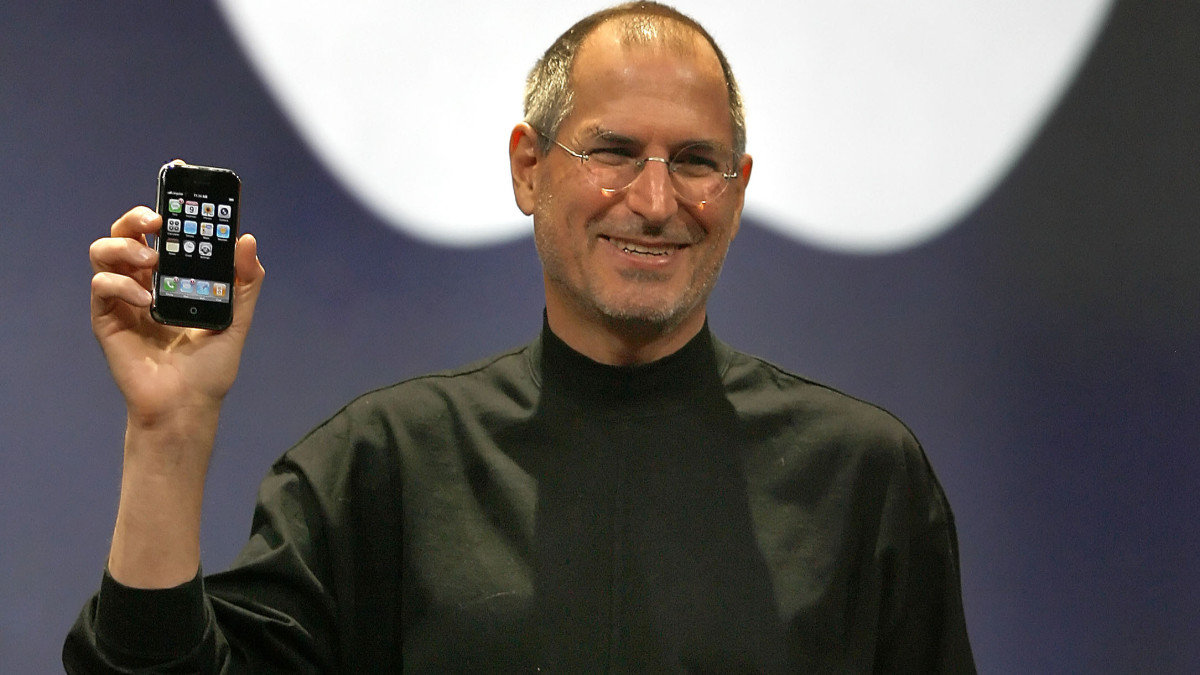Remembering the best Steve Jobs moments at WWDC across the years
'Now, stop me if you've seen this.'

WWDC is just a few weeks away, and with that in mind, we wanted to take our minds back to the most memorable moments of when Steve Jobs would take the stage.
Between 1997 and 2011, he would announce a bunch of features and landmarks that would alter the course of where Apple was going - from the switch to Intel in 2005, to the debut of iCloud in 2011.
He was a natural showman, and even when there were elephants in the room, such as the stolen iPhone 4, he approached it with a joke, something that you rarely see in the Apple of today.
So with this in mind, we’re going through Jobs’ most memorable moments at WWDC across the years.
A Farewell to Mac OS 9 with a mock funeral - 2002
John-Anthony Disotto — How-To Editor
In 2002, Steve Jobs bid farewell to the beloved Mac OS 9 with a comic skit you’re likelier to see on Saturday Night Live than the keynote at WWDC 2023. Jobs gave a eulogy as an organ played, and a Mac OS 9 box was laid to rest inside a casket.
Looking back, over 20 years later, it’s actually refreshing to see a light-heartedness to an Apple keynote that we don’t often see nowadays. Jobs, in his eulogy, made jokes about Mac OS 9 requiring regular restarts to “remember who he is” and other self-deprecating jokes about Apple products that you just don’t see today.
iMore offers spot-on advice and guidance from our team of experts, with decades of Apple device experience to lean on. Learn more with iMore!
How refreshing would it be if Tim Cook took to the stage on June 5th and told the world that Siri was dead and we were getting a “smart” assistant in iOS 17? He could even tell us that Siri was a “kind soul that often didn’t have a clue.” Unfortunately, we won’t get much humor in Apple’s keynote, and we definitely won’t get any self-deprecating jokes. But that’s ok because we might get a VR headset so we can watch Steve Jobs give a eulogy to a dead operating system.
iPhoneOS 2.0 and the App Store - 2008
Tammy Rogers — Staff Writer
When the iPhone was launched in 2007, Jobs had planned to allow third-party developers to build apps that would run within Safari – but not natively on iPhone. There wasn’t going to be a centralized way to get apps running on iPhone, and the only way that you’d see a new app logo on your home screen was as if Apple designed it time to add something new. Developers and users didn’t like this too much – and so, Apple does as Apple does, and along came the walled garden that is the App Store.
Jobs came to the stage in 2008 during the announcement of the new Apple App SDK (Software Development Kit), alongside demonstrating the App Store. Most of it was as you might expect – the App Store would be filled with apps, making sure that you can get your creation in the eyes of iPhone users.
There was something innately un-Apple about the whole affair, with Jobs noting price changes and, to some shock, free apps that wouldn’t cost the user, or crucially the developer any money. The App Store felt like there was a ‘developer first’ mentality at its core, and Jobs, as calm and collected as he always was, looked resigned here, as if it was something he wasn’t all that excited about.
Where customers wanted the App Store, it felt like Jobs didn’t – and while now it's one of the strongest elements of the ecosystem, it was completely new to everyone at the time. Jobs' cadence changed, however, with the news that the app store wouldn’t just be coming to the iPhone, but to the iPod touch as well.
The iPod always felt like it was Jobs' baby. He helped bring it to market, he pulled the tiny nano from his pocket to gasps and awws, and he showed the world the iPod Touch the year prior. The App Store on the iPod touch was the next big step for his device, and while he saw the iPhone as something he wanted to remain unmolested by third-party developers, he saw the app store as something that could make the iPod the device for everybody.
The App Store remains one of the most comprehensive app libraries out there, and while Jobs seemed unenthused in 2008, it’s completely unavoidable how successful and widespread it has become.
Switch to Intel confirmed - 2005
Karen Freeman — Contributor
At WWDC in 2005, a robust and healthy Steve Jobs announced that Apple would be switching from PowerPC microprocessors (supplied by Freescale, formerly Motorola, and IBM) to Intel’s x86 architecture.
Over the course of the next year, Apple did indeed make the CPU switch for Mac and Xserve (Apple-designed servers) computers. This marked an important new partnership that would last a decade and a half.
The Intel chips would continue to power all of Apple’s computers until 2020, when Apple began transitioning to its own Apple Silicon.
iPhone 4 reveal - 2010
Daryl Baxter — Features Editor
Back in 2010, we didn’t have ‘leakers’ and ‘renders’ of the next iPhone. Rather, we would have near radio silence as to what the next iPhone would be, and some rumors as to what the next version of iPhoneOS may feature.
But that all changed when the iPhone 4 was mistakenly left in a bar. You see, an Apple employee was testing out this unreleased iPhone in the wild, to make sure its cellular hardware and features worked correctly in the outside world. But one mistake meant that someone spotted this iPhone, took it, and sold it to a website.
A few months later, the keynote at WWDC began, and Steve Jobs announced the iPhone. When it came to the ‘design’ of this model, he started with: “Stop me if you’ve already seen this,” to the laughter of the whole crowd.
That put a pin to any tension or elephants in the room. Instead, Jobs charmed the audience and carried on, continuing to sell why the iPhone 4 had a redesign, and explaining what the border around the iPhone was. While this eventually tuned into Antennagate, his showcase of the iPhone 4 was jovial, impressive, and a masterclass in showmanship - something that you could argue Apple misses in its keynotes of today.
When showmanship was key at Apple’s keynotes
It’s widely agreed that the best keynote that Steve Jobs ever did was the original iPhone announcement at Macworld in January 2007. It was a masterclass in teasing the audience, justifying why this new product had to exist, and above all, how it worked.
But WWDC always had a different feel, even before iPhone announcements were a trope before it changed to the fall in 2011. Jobs had a way of relating to developers, and understood, especially before Apple became the behemoth that it is today, that these were the lifeblood of Apple’s products.
Without developers, there were no apps, and with no apps, meant that the appeal of Apple’s products to new customers would be much more of a challenge.
It’s why events at WWDC such as the App Store, the iPhone 4 reveal, and even the mock funeral of Mac OS 9 are still great to watch time and time again. He shows a level of casualness and camaraderie that’s missing from the keynotes of today, and it makes you enjoy watching them more.
While it’s a tragedy that he’s no longer around, the fun of Apple is still abound in its products, and, hopefully, in its rumored VR headset if it does get announced at WWDC on June 5.

iMore.com is your source for all things Apple, and the IM Staff author represents our collective hivemind, for those occasions when the whole team speaks with one voice to bring you important updates about the site, editorial policies, awards, promotions and more.
The iMore team of Apple enthusiasts and experts shows you how to get the most out of your tech life by using Apple products and the apps, services, and devices they connect with to their fullest. iMore is a mainstay in the Apple community for good reason. Every single iMore writer and editor takes their job seriously, and we prioritize accuracy and editorial independence in everything we do, never receiving compensation for coverage and never pulling punches.
As well as our amazing group of regular contributors, the iMore staff team currently consists of:
Gerald Lynch — Editor-in-Chief
Stephen Warwick — News Editor
Daryl Baxter — Features Editor
John-Anthony Disotto — How To Editor
Tammy Rogers — Senior Staff Writer
James Bentley — Staff Writer
- John-Anthony DisottoHow To Editor
- Karen S FreemanContributor
- Tammy RogersSenior Staff Writer
- Daryl BaxterFeatures Editor
